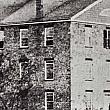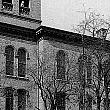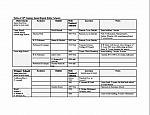
Central School: Architects and Architecture
by Diana Barrett
Superintendent E.A. Strong, in his June of 1863 Annual Report elaborated some of the problems with conditions at the east side Union School. In September of that year, 1863, at a meeting of the voters it was decided:
1. They needed to build a new Union Schoolhouse.
2. Messrs. Thomas D. Gilbert, William H. Withey, and P.R.L. Pierce were to be a committee to confer with the Trustees, and in conjunction with them to procure a plan and superintend the construction of such a school house.
The rise in the price of labor and building materials due to the Civil War, and the “extraordinary issues of paper money, rendered it impossible for the Board to erect such a building with the sum ($25,000) to which they were limited by vote of the district.”[1] This seems an appropriate place to redirect our attention from a surplus of students and a scarcity of space to the architect and architecture of the new District No.1 Union School, commonly referred to as Central School. It is the first local school building with some semblance of identifiable architectural style, in this case, a mid-western version of Italianate.
Though the use of the Italianate architectural style is a distinct departure from earlier, sometimes vaguely neo-classical designs, it became common in school construction in the northern United States in the years after the close of the Civil War. Less grand in appearance than its classical predecessors, the Italianate form seemed ideally suited for school purposes, its boxy, asymmetrical profile allowing buildings of varying sizes to be accommodated within the style. Italianate buildings could also be built to three or more stories in height without compromise of overall appearance.
The style called for the use of large symmetrically balanced windows (generally topped by a decorative cornice), permitting lighter, more airy school rooms, and as was the case with the new Union Schoolhouse, welcomed the placement, usually off-center, of a commanding tower housing stairs, additional rooms, or perhaps a belfry.
The relative simplicity of the overall form, generally free of elaborate ornament, such as columns and pediment, brought down the cost of original construction (as well as subsequent additions), and placed the actual construction of the building well within the capabilities of local contractors.
It is unknown if the plans for the building were contracted for and secured in 1863 when the committee was instructed to obtain them, or if that duty was postponed as well as the construction itself, by prevailing financial conditions. Regardless, Thomas Pratt of Northampton, Massachusetts, produced the elevations for the proposed school—the first in the city to be designed by an ‘outside’ architect.
The choice of Thomas Pratt was interesting, but a little puzzling. We are all familiar with the notion that an expert is someone who lives fifty miles from home. Perhaps thinking the school would be of more consequence if designed by an expert led to the choice of Pratt. But why so far from home?
The most practical answer may be that someone connected to the project here came from the Connecticut River Valley of Massachusetts, and knew of Pratt’s work. If we assume that the plans were sought in 1863, Pratt would have been eighty years old and well past the days of his major work, which consisted almost exclusively of Greek Revival styled domestic architecture. .jpg) We have to ask, is it possible he was assisted in completing the elevations by his son, William Fenno Pratt, also an architect? His portfolio included designs in the Italianate vernacular; one of his most well-known being Evergreens, designed for William Austin Dickinson (known as Austin), brother of the poet, now part of the Emily Dickinson Museum in Amherst.
We have to ask, is it possible he was assisted in completing the elevations by his son, William Fenno Pratt, also an architect? His portfolio included designs in the Italianate vernacular; one of his most well-known being Evergreens, designed for William Austin Dickinson (known as Austin), brother of the poet, now part of the Emily Dickinson Museum in Amherst.
Two names come forward as potential contacts to Thomas Pratt. David Burnett, builder of the earlier East Side Stone School, was from South Hadley, Massachusetts, just across the Connecticut River from Northampton. Thomas D. Gilbert, of the 1863 building committee, left that area of Massachusetts shortly before 1835, the time of Pratt’s heyday, and so may have known of his work. We discover that, “Pratt was the architect of the building, although the incipient scheme and many special suggestions and adaptations are due to Thomas D. Gilbert.”[2]
Julie Stivers, Grand Rapids author, has provided the answer to the selection of the architect for the school. Thomas D. Gilbert would indeed have been the connection. Austin Dickinson, brother of poet Emily, was married to Thomas Gilbert's sister, Susan. Austin and Susan Gilbert Dickinson had thought about moving to Grand Rapids soon after they married, to take advantage of the success of her brothers, Thomas and Francis Gilbert. However, Mr. Dickinson, Austin's father, offered to build them a house if they would stay in Amherst. As mentioned, Thomas Pratt's son, William Fenno Pratt, designed that house, Evergreens. Considering the age Thomas Pratt, the architectural style of the school, and the Dickinson connection it's most likely that it was Pratt's son William who was the actual architect.
Popularity of the Italianate style increased after the Civil War, particularly in school buildings, offering local communities a style newer and more up-to-date than the Classical or Greek Revival buildings of the past. A few identifying Italianate features of the Central School include the square tower topped by a square cupola; tall, narrow windows arched above with crowns in an inverted ‘U’ shape that vary in design from floor to floor; and a low-pitched roof with overhanging eaves supported by decorative brackets.
There are deviations from true Italianate architecture in the school that a trained eye would have spotted immediately, i.e. the pitch of the roof of the tower and the lack of ornamentation, especially on the windows, normally identified with this style. Thomas Gilbert’s hand as well as financial restraints of the war may explain the less than accurate rendering of Pratt’s original design.
Some critics were not forthcoming with praise for the Pratt/Gilbert building. “Though somewhat faulty in its architectural style, [it] is a most substantial, thoroughly finished structure . . . a pity that there was not more cheerfulness built into its form, and [was] not made to express more sympathy with the progressive spirit of the age. It looks a little pinched in some portions as though something hurt it, but with all its architectural faults, it is a noble building.”[3]
The new Central School occupied the same site as the Stone School, but its footprint was two and one-half times the square footage of the earlier building. Constructed of brick, as almost all future schools would be, it could house 600 pupils, 700 if really necessary. The tower, located on the southeast corner, furnished an office for the Superintendent on the first floor, a room for the Kent Scientific Institute collection on the second, and a recitation room for modern languages on the third.
After the new high school was finished, the old school was demolished. The stones and building materials were sold to various citizens, and the front door of the school was added to the residence of Arthur S. White, editor and journalist.[4]
Who Did the Work on the New Central School?
|
"In 1867/68 when the Central School was built it was not the custom, as it is today, for a general contractor to oversee contracting craftsmen to complete a building. The school board, or more specifically the building committee, would have had the responsibility of hiring men from each of these trades. Superintendent E.A. Strong in his 1868 report gave credit to the ‘mechanics’ who had “Done the Work” on the Central School. “The contractors have given to the work, throughout, their personal attention, and so well has the mason work been attended to by Mr. L.C. Davidson, that not a crack in the walls is visible, from foundation to turret. Mr. A.W. Pelton had the charge of the carpenter work, including the large self-supporting roof, and has fully maintained his reputation as a skillful mechanic. The joiner work has been under the personal supervision of Mr. L.N. Howard, assisted much of the time by Mr. Chas. N. Rice, Gilbert Grootvelde, Gerritt DeGraaf, M.H. Wileman, J. Miller and the Messrs. Colby, and needs no commendation. The plastering was done by Dennis Heenan, Patrick O’Neill, Lewis Colwell, Augustus David, Nicholas Alt, and James L. Davidson, and we think will prove durable work. The graining was done by Mr. Wm. Hodgson, in his usual thorough manner, and the rest of the painting, oiling and varnishing, by Cornelius Borendamme. The tin work, heating apparatus, etc. has been under the supervision of Capt. Fred. Shriver, a sufficient guarantee that the work is of the best kind. Mr. Thomas Pratt, of Northampton, Mass., was the architect, and designed the elevations after having been furnished the ground plans by the Board. The severe simplicity and massive character of the style have been criticized by some, but the Board are of opinion that it is in keeping with the purpose of the building. Mr. Reuben Wheeler, of this city, has been consulting architect during the progress of the work, and aided materially in its development.” |
Reuben Wheeler was not a trained architect, but a builder/mechanic. Wheeler worked his way west as a skilled carpenter and builder after studying design in Buffalo. He practiced in Detroit, Chicago, and St. Louis before coming to Grand Rapids in 1855 to join his brother, who worked as a mason and plasterer. Wheeler is listed as a carpenter in the 1859 City Directory. Entries in his personal account book show his work to be largely residential from this period. In 1866, he established Reuben Wheeler & Company to manufacture doors, sash, blinds and other building fixtures. By 1870, the company employed over sixty-five people and was the largest manufacturer of its kind in the city. He designed and built a number of brick commercial Italianate style blocks in downtown Grand Rapids during the 1870s. The Italianate buildings fronting on Monroe Center (part of the Ledyard Block Historic District) and the Peck Block at Monroe Center and Division are the only known commercial examples of Wheeler’s work that survive today.[5]
William G. Robinson, who would design many Grand Rapids buildings, especially its early schools, worked for Reuben Wheeler as a draughtsman when he first arrived in the city.[6]
|
Normally, the itemized charges for a schoolhouse would not be included, but a glimpse into building costs of the 1860s as well the types of items required proves interesting. |
|
|
Contract price |
$40,000.00 |
|
Cistern |
245.10 |
|
Cost of plan |
303.02 |
|
Moving wood-shed and privy |
23.00 |
|
Excavating for basement |
514.86 |
|
Bill of lumber for various uses |
47.62 |
|
Surveying |
12.00 |
|
Grading lot |
137.77 |
|
Cut stone water table |
380.61 |
|
Corner stone |
3.25 |
|
Painting and sanding window caps |
139.32 |
|
Gas fitting |
134.51 |
|
Interest on temporary loan |
70.83 |
|
Extra allowance on brick |
75.00 |
|
Paid for house and lot adjoining school lot |
1001.75 |
|
Stamps on school bonds |
7.55 |
|
Stoves, furniture, seats, desks, fitting up library and apparatus room |
1362.88 |
|
Lightning rods |
122.20 |
|
Fire grates |
92.75 |
|
Labor outside, stone walls, stairs, walks, cellar under janitor’s house, moving house paving, etc. |
431.73 |
|
Total |
$45,105.75 |
|
We estimate the cost of heating apparatus. |
(not listed) |
|
We estimate due contractors for extra work |
1,500.00 |
|
Amount of outstanding bills |
500.00 |
|
For out-houses, grading and fencing lot, planting trees and laying permanent walks |
3,000.00 |
[1] GR Eagle, 4/25/1867
[2] GR Eagle, 4/25/67 (emphasis by current author)
[3] GR Eagle 4/11/1868 (Possibly a comment by Albert Baxter, editor of the Eagle?)
[4] Baxter, Albert. History of the City of Grand Rapids. 1891. p 220, 221
[5] PastPerfect Downtown Survey, 2000
[6] Grand Rapids City Directory, 1868-69
Note: "Who did the work" and "costs of the building" are from Superintendent E. A. Strong's s report in the 1868 Annual School Board Report, pgs. 16-17.

 facebook
facebook














